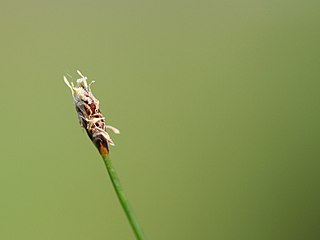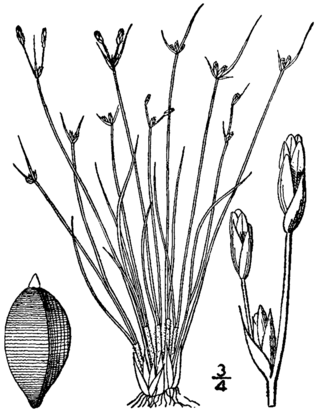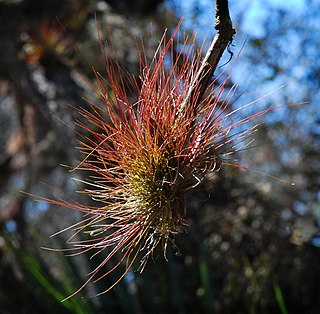
The water caltrop is any of three extant species of the genus Trapa: Trapa natans, Trapa bicornis and the endangered Trapa rossica. It is also known as buffalo nut, bat nut, devil pod, ling nut, mustache nut, singhara nut or water chestnut.

Echinodorus berteroi is an aquatic plant species in the Alismataceae It is native to the southern and central parts of the United States, as well as Central America, the West Indies, and South America as far south as Argentina.

Brasenia, commonly known as watershield, is a genus belonging to the family Cabombaceae, consisting of one species, Brasenia schreberi. It is widely distributed in North America, the West Indies, northern South America, eastern Asia, Australia, the Indian Subcontinent, and parts of Africa.

Gynerium is a monotypic genus of Neotropical plants in the grass family, native to Mexico and Colombia, Central America, South America, and the West Indies. It is classified in its own tribe Gynerieae.

Eleocharis is a virtually cosmopolitan genus of 250 or more species of flowering plants in the sedge family, Cyperaceae. The name is derived from the Greek words ἕλειος (heleios), meaning "marsh dweller," and χάρις (charis), meaning "grace." Members of the genus are known commonly as spikerushes or spikesedges. The genus has a geographically cosmopolitan distribution, with centers of diversity in the Amazon Rainforest and adjacent eastern slopes of the South American Andes, northern Australia, eastern North America, California, Southern Africa, and subtropical Asia. The vast majority of Eleocharis species grow in aquatic or mesic habitats from sea level to higher than 5,000 meters in elevation.

Eleocharis acicularis is a species of spikesedge known by the common names needle spikerush and least spikerush. It is widespread across Europe, central and southeastern Asia, North America and northeastern South America as far south as Ecuador. It is also found in Australia, where it is probably an introduced species.

Erechtites hieraciifolius is a plant in the daisy family, Asteraceae. It is native to the Americas, but is found many places around the world having been introduced by human activity. It is introduced in Hawaii, China, and Southeast Asia.
Eleocharis atropurpurea is a species of spikesedge known by the common name purple spikerush. This is an aquatic plant native to much of. It also has a wide distribution in temperate regions of North and South America and Asia. It is present in Europe, where it may be an introduced species for the most part.
Eleocharis geniculata is a species of spikesedge known by several common names, including bent spikerush and Canada spikesedge. This is a widespread plant of wet areas in the Americas, Asia, Africa, Australia, Madagascar, and some Pacific Islands. It is an annual spikesedge growing to a maximum height of about 40 centimeters. It has a few straw-colored leaves and many thin erect stems. The stems hold inflorescences of rounded spikelets each containing at least 10 tiny flowers. The flowers are covered with dark greenish-brown bracts. The fruit is a shiny purple-brown achene not more than a millimeter long.

Bulbostylis capillaris is a species of sedge known by the common names densetuft hairsedge and threadleaf beakseed. It is native to much of North America, South America and the West Indies from Canada to Bolivia.
Eleocharis montevidensis is a species of spikesedge known by the common name sand spikerush. It is a widespread coastal plant native to the Americas. It grows in moist, sandy spots in many habitat types, including lakes, riverbanks, wet meadows, and springs. It has a disjunct distribution, in North America and South America.

Eleocharis parishii is a species of spikesedge known by the common name Parish's spikerush.

Eleocharis parvula is a species of spikesedge known by the common names dwarf spikerush, small spikerush and hairgrass in aquaria. It is a plant of brackish and saltwater habitat, such as marshes and mudflats. It is a perennial herb growing tufts of spongy, compressible stems not more than 10 centimeters tall. The plant grows from a tuber which is J-shaped or horseshoe-shaped, a characteristic that helps in the identification of the species. The inflorescence is an oval-shaped spikelet just 2 or 3 millimeters long, made up of several tiny flowers.

Eleocharis quadrangulata is a species of spikesedge known by the common names square-stem spikerush and four-angled spikerush. It is native to eastern and central North America, with additional populations in California, Oregon, and west-central Mexico. It grows in and around freshwater in lakes, ponds, and other bodies of water. It is a rhizomatous perennial herb growing one half to one meter in height. The spongy, compressible stem is a few millimeters wide and sharply four-angled. The inflorescence is a single spikelet 1.5 to 7.5 centimeters long which is made up of several flowers covered in light brown bracts.

Tillandsia balbisiana, common name northern needleleaf, is a species of bromeliad in the genus Tillandsia. This species in native to Mexico, Central America, Colombia, Venezuela, the West Indies, and Florida.

Tillandsia setacea, the southern needleleaf, is a species of flowering plant in the genus Tillandsia. It has a scattered, disjunct distribution in the southeastern United States, northwestern and southern Mexico, Guatemala, the West Indies and the State of Pará in northeastern Brazil.

Triodanis perfoliata, the clasping Venus' looking-glass or clasping bellflower, is an annual flowering plant belonging to the family Campanulaceae. It is an annual herb native to North and South America, the natural range extending from Canada to Argentina. It is also naturalized in China, Korea and Australia.

Solanum diphyllum, commonly known as the twoleaf nightshade, is a species of nightshade native to the Americas. It is cultivated as an ornamental plant for its clusters of dark green round fruits that turn a bright yellow when ripe.
Dendrophylax porrectus, the jingle bell orchid, or needleroot orchid, is a species of epiphytic orchid native to Mexico, El Salvador, Guatemala, Florida, Cayman Islands, Cuba, Hispaniola, Jamaica, and Puerto Rico.

Eleocharis flavescens is a perennial flowering plant species called bright green spikerush, pale spike-rush, or wrinkle-sheathed spike-rush; it is a member of the sedge family, Cyperaceae. It is clump-forming species that also spreads into colonies. It is a small species that looks similar to other Spikerush species. It is native to temperate North America, the West Indies, and South America.
















